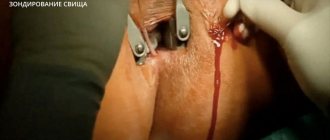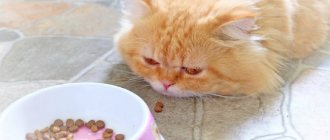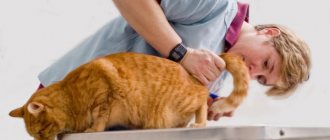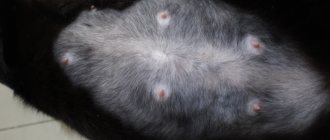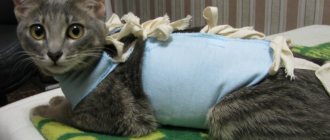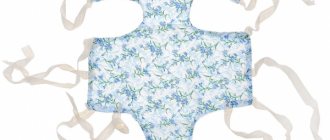Although cats are much more susceptible to these problems, swollen nipples and mammary glands are sometimes observed in male cats. An unspayed female is at greater risk than a spayed female. If unusual mammary swelling is noticed while the kittens are nursing, the kittens and their mother may need veterinary attention as the infection can easily spread between them.
Swelling of the nipples and mammary glands are external manifestations of enlarged mammary glands. Most cats have eight nipples, and if one or more nipples become enlarged or inflamed, one or more of them may be affected. Normal events in a cat's life can cause mammary tissue to swell, such as pregnancy and lactation. However, many infections and other conditions that can be life-threatening also cause breast enlargement.
Causes
Why are my cat's mammary glands swollen? The most common reasons are: :
- pregnancy;
- mastitis;
- false pregnancy;
- mastopathy;
- benign neoplasms;
- cancer.
© shutterstock
If the cat is not pregnant, then you need to contact your veterinarian to determine the cause.
Complications after sterilization
To avoid complications after sterilization, you need to make sure that the cat is healthy. Undergo a full medical examination to identify inflammation or the presence of chronic pathologies in the body. Make sure there is no ovulation, otherwise after the operation a false pregnancy may occur, which is fraught with the manifestations described above.
Before the operation, you should undergo a full medical examination.
Mastitis
Most often, a cat gets mastitis as a result of stagnation of milk in the breast. Another cause may be infection with staphylococcal infection or E. coli. Bacteria also enter the gland through the milk ducts or through the bloodstream.
Mastitis is an inflammation of the cat's breasts. Most often this disease is characterized by symptoms :
- an increase in the size of the gland, swelling, swelling;
- increased cat body temperature;
- redness of the skin of the mammary glands;
- seals may appear;
- blood or pus can be expressed with milk;
- general deterioration in the animal’s well-being, lethargy, apathy.
If mastitis is not treated on time, then in some cases degeneration of the mammary glands may occur, which will lead to the development of tumors, including malignant ones. What should you do if your cat has swollen upper four mammary glands? First of all, it is necessary to take the animal to a veterinarian and examine it for mastitis.
© shutterstock
False pregnancy
False pregnancy is a common occurrence in the animal world. Dogs most often suffer from this problem, but it also occurs in cats. Usually, a false pregnancy occurs after mating with a sterile male. The problem may also arise due to reproductive ill health of the cat itself. Sometimes false pregnancy occurs due to hormonal imbalances in the animal’s body.
If, some time after meeting a male, the cat’s mammary glands swell and her belly becomes rounded, this does not mean anything. The presence of pregnancy can be determined using an ultrasound machine. Usually this study is prescribed by a doctor for a period of 3-4 weeks.
Symptoms of false pregnancy in a cat:
- toxicosis;
- swelling of the mammary glands;
- abdominal enlargement due to excess fat deposition on the anterior abdominal wall;
- appearance of milk;
- false labor pains.
What to do if a cat is falsely pregnant? This condition is not so harmless, so a visit to the veterinary clinic is required. If episodes of false pregnancy occur frequently, then the cat must be sterilized.
Mastopathy
Mastopathy is a pathological change in the gland, characterized by the appearance of dense formations. This disease practically does not occur in cats that were sterilized before the age of one year. Mastopathy is a dangerous process that, without veterinary control, can further provoke the growth of a cancerous tumor.
© shutterstock
What to do if your cat has swollen mammary glands? It is necessary to take the animal to the clinic and rule out mastopathy .
Main symptoms of the disease:
- enlargement of the mammary glands;
- the appearance of bloody discharge from the nipples;
- the presence of seals in the gland;
- The animal's chest may become painful.
For mastopathy, conservative treatment is most often prescribed, which is well tolerated by cats. If an animal has swollen mammary glands, it is better to take it to a doctor as soon as possible for diagnosis.
Diagnostics
When you arrive at the clinic, your veterinarian will need a complete medical history of your cat. A physical examination will be performed, during which the nipples and breast tissue will be carefully examined for signs consistent with breast health. Some problems may not be serious and may resolve on their own, while other conditions may be life-threatening.
A number of diagnostic tests may be done, usually starting with a blood test. This may include a complete blood count and biochemical profile. A biopsy of the enlarged tissue may be taken for further microscopic evaluation (histopathological examination). X-rays of the chest and abdomen may be needed to check the location of the tumor and detect metastasis (spread). A urine test can be used to confirm and identify bacteria present in a cat.
Benign neoplasms
Veterinarians call the most common causes of benign neoplasms hormonal imbalances, injuries to the mammary glands and genetic predisposition. Unsterilized cats and overweight animals are at risk. The use of hormonal contraceptives increases the likelihood of breast tumors.
Symptoms of the disease:
- the cat's mammary glands are swollen;
- upon palpation, a compaction is felt under the skin;
- lymph nodes may be enlarged;
- sometimes there is discharge from the nipples;
- the behavior of the animal may change.
If an animal's mammary glands are swollen, this may be a symptom of tumor development. In cats, most neoplasms are malignant, so it is necessary to consult a veterinarian as soon as possible.
Treatment
At home, help can be provided only in the initial stages of the disease. Although it is worth noting a number of nuances.
Firstly, it is important to treat only catarrhal and serous forms at home. Secondly , nulliparous cats must visit the clinic. A common cause of mastitis is stagnation of milk followed by infection, which is accompanied by inflammation. But, if the swelling of the nipples goes away without discharge, then the reason is different. It can only be determined in a veterinary clinic.
Thirdly, if not all mammary glands are swollen, then the affected parts can be sealed with a bandage or bandaged. If necessary, isolate kittens. Under no circumstances should babies be fed contaminated milk. Especially with purulent mastitis.
External signs of illness when it is reasonable to treat at home:
- The cat's temperature is normal.
- There is no purulent, bloody or other unusual discharge.
- The nipples are a little swollen.
- Only part of the mammary glands is affected.
- The cat does not experience pain upon palpation.
- The milk ducts in the nipples are not blocked.
If after a few days the cat's condition does not improve, you should contact your veterinarian. We list the most effective ways to help alleviate your pet’s condition.
Express milk
IMPORTANT! Under no circumstances should you do this with your hands! Any touch during mastitis is extremely painful.
You should use a regular 5-10 ml syringe. We remove the piston and cut off the upper tip. Then we treat the resulting space with fire. A regular lighter will do. Level the surface with your fingers.
We insert the plunger, applying the syringe to the nipple. The milk will be expressed unless there is a blockage. The procedure will require the help of a partner. If your cat is in severe pain and tries to escape, you should immediately consult a doctor.
The milk is expressed until the nipples become flaccid. Light pressure should not cause pain to the cat. The lumps disappear, the swelling decreases in size.
Light massage
Don't be overzealous. A high-quality massage is similar to gently scratching the abdomen, avoiding the most sore spots if possible.
Warm compresses
Use a decoction of chamomile, oak or sage. A tablespoon of the mixture is brewed with 200 ml of boiled water and left for 30 minutes. Cools to a comfortable temperature. A bandage or napkins are moistened with the broth and applied to the affected areas. Covered with cellophane and bandaged loosely.
Rubbing with ichthyol or camphor oil helps effectively. The treated areas are also covered with a bandage. It is also needed to prevent the cat from licking the oil.
Limit food and water
When using dry food, water is given only after meals. Otherwise, the cat is given water once until it is completely saturated. The next day, it is advisable to switch the animal to dry food. The diet is maintained until the first symptoms of recovery.
In a clinical setting, in most cases, drug treatment is used. It depends on the type of mastitis. Let's note some of the ways:
- Intravenously or intramuscularly - 10% sodium gluconate (1-3 ml repeated every other day), 10% catozal (0.5 - 2.5 ml for 3-5 days), gamavit (0.3-0.5 ml per 1 kg of body for a week), mastomethrin (0.5-2 ml 1-2 times a day for 2 weeks), traumatin (0.1 ml per 1 kg of body 1 time a day for 5 days).
- The use of antibiotics - cephalosin (20-25 mg every 8 hours for 5 days), cephalexin (10-30 mg 2 times a day for 5 days). Often a novocaine blockade is used with the addition of penicillin or bicillin for 2 days.
- In severe cases, surgical intervention is resorted to. Remove pus, express milk, get rid of affected areas.
Each case is individual and only after a full examination will the veterinarian be able to prescribe effective treatment
Malignant neoplasms
Mammary cancer in cats is a malignant neoplasm that in the later stages begins to metastasize to other organs. If detected early, animals are much more likely to survive. Malignant neoplasm is one of the most dangerous diseases of the mammary glands in cats.
© shutterstock
Most common symptoms in the early stages:
- the cat has swollen mammary glands;
- upon palpation, compactions are felt;
- enlarged lymph nodes;
- the animal may become lethargic and lazy.
In later stages, the tumor is already visible to the naked eye. It increases in size and grows into the surrounding tissue. With the blood flow, its cells spread throughout the animal’s body. In feline breast cancer, metastases are most often found in the lungs, liver and brain. The tumor begins to disintegrate, and a little later the animal dies. Veterinarians are powerless here; euthanasia is recommended.
Mastopathy in a cat
It happens that some time passes after sterilization and the owner notices swelling of the mammary glands in his pet.
With more careful palpation, you can feel small compactions with a soft or springy consistency . This is how mastopathy manifests itself. The initial stage of the disease does not cause a painful syndrome, so timely diagnosis of the pathology is of great importance.
If such a symptom is detected, you should immediately contact the clinic for a correct diagnosis and treatment.
If symptoms of mastopathy appear, you should immediately contact a veterinarian!
Diagnostics
Diagnosed using histological examination.
Histological examination.
Risk group
Females who have been spayed after at least their second heat are more at risk.
Younger females who have had their ovaries removed before their first estrus are very rarely susceptible to developing this disease.
Young cats are less susceptible to the disease after surgery.
Treatment
Treatment is prescribed depending on the severity of the course.
If the disease is diagnosed late, surgery is recommended, during which the affected tissue or completely swollen gland is removed.
If the disease is detected late, surgical intervention is recommended.
The initial stage is amenable to drug treatment. The use of immunomodulatory drugs to enhance the body's resistance is indicated. Iodine-containing medications are prescribed to stop the growth of pathological tissue.
To prevent secondary infections and eliminate pain, treatment with anti-inflammatory drugs is recommended.
homeopathic remedies are used to restore the female’s hormonal levels. Under no circumstances should you use warm compresses or lotions for mastopathy. Heat provokes the proliferation of diseased cells.
